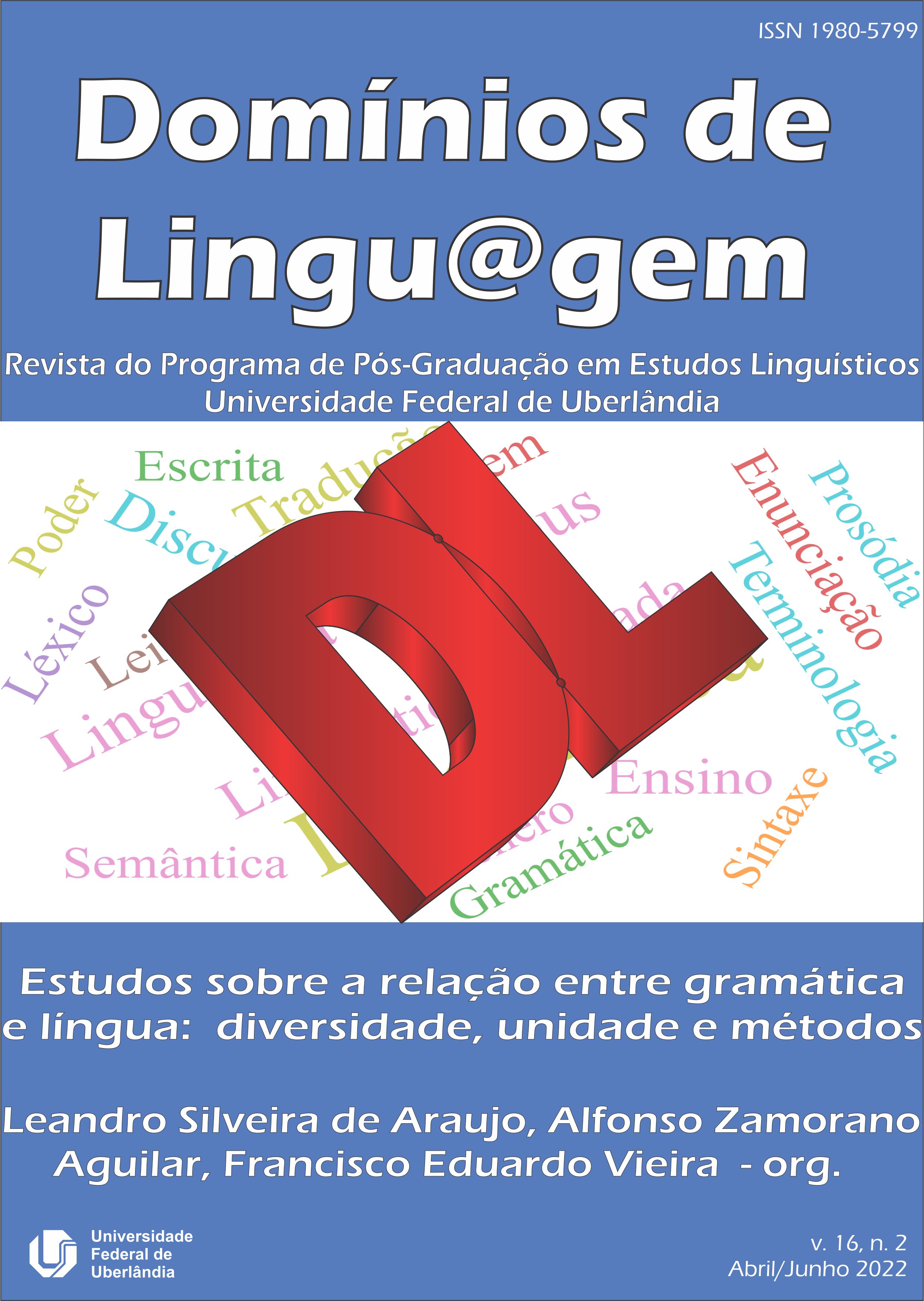Theoretical-practical reflections on the teaching of linguistic variation in Portuguese
DOI:
https://doi.org/10.14393/DL50-v16n2a2022-10Keywords:
Portuguese language teaching, Educational sociolinguistics, Pedagogy of linguistic variation, Strip production, Standard and language varietiesAbstract
This article reflects on the phenomenon of linguistic variation and pattern employed in society from the theoretical foundation of the pedagogy of linguistic variation and guided by the guidelines of current Brazilian official documents, such as the National Curriculum Parameters (BRASIL, 1998) and Common National Curriculum Base (BRASIL, 2017) in relation to the associated perspectives. The discussion is based on a teaching proposal effectively carried out in which 8th grade students from elementary school, from the contact with the concepts of linguistic variation, they appropriated this knowledge and and produced strips, incorporating experiences of social interaction in their textual productions. The characters chosen for the preparation and application of the proposal are from Turma do Xaxado, by Antônio Cedraz. For the development of the activities, action research procedures were adopted (THIOLLENT, 1986) whose methodology articulates the production of knowledge with educational action. The objective of this work is to show an effective teaching proposal that approaches the language as a variable phenomenon through the genre strips. For this, we base ourselves on scientific researches that focus on teaching with a sociolinguistic basis, such as Bortoni-Ricardo (2004, 2005), Faraco (2008), Bagno (2007, 2013); Coelho et al. (2015) and Silva (2001). Analyzing the strips produced by the students, we aimed to highlight their perceptions of language as a heterogeneous phenomenon and corroborate the effectiveness of teaching proposals based on the scientific perspective of educational sociolinguistics.
Downloads
Metrics
References
BAGNO, M. Nada na língua é por acaso: por uma pedagogia da variação linguística. São Paulo: Parábola Editorial, 2007.
BAGNO, M. Preconceito linguístico: o que é, como se faz. 55. ed. São Paulo: Edições Loyola, 2013.
BECHARA, E. Moderna gramática portuguesa. 37. ed. Rio de Janeiro: Nova Fronteira, 2009.
BORTONI-RICARDO, S. M. Educação em língua materna: a sociolinguística na sala de aula. São Paulo: Parábola Editorial, 2004.
BORTONI-RICARDO, S. M. Nós cheguemu na escola, e agora? Sociolinguística e Educação. São Paulo: Parábola Editorial, 2005.
BORTONI-RICARDO, S. M. O professor pesquisador: introdução à pesquisa qualitativa. São Paulo: Parábola Editorial, 2008.
BRASIL – Secretaria de Educação Fundamental – Parâmetros curriculares nacionais: terceiro e quarto ciclos do ensino fundamental: língua portuguesa / Secretaria de Educação Fundamental. Brasília: MEC/SEF, 1998.
BRASIL, Ministério da Educação e Cultura. Base Nacional Comum Curricular. Brasília: MEC/SEB, 2017.
CAGNIN, A. L. Os quadrinhos: linguagem e semiótica: um estudo abrangente da arte sequencial. São Paulo: Criativo, 2014.
CAMACHO, R. G. Norma culta e variedades linguísticas. In: Universidade Estadual Paulista. Prograd. Caderno de formação: formação de professores didática geral. São Paulo: Cultura Acadêmica, 2011, p. 34-49, v. 11.
CEDRAZ, A. L. R. Xaxado ano 1. Salvador: Editora e Estúdio Cedraz, 2003.
CEDRAZ, A. L. R. A Turma do Xaxado – volume 2. Salvador: Editora e Estúdio Cedraz, 2006.
CEDRAZ, A. L. R. A Turma do Xaxado – volumes 1 e 2. 3. ed. Fortaleza: Editora IMEPH, 2010.
CEDRAZ, A. L. R. 1000 tiras em quadrinhos. São Paulo: Martin Claret, 2012.
COELHO, I. L. et al. Para conhecer sociolinguística. São Paulo: Contexto, 2015.
COSERIU, E. Sincronia, Diacronia e História: o problema da mudança linguística. Tradução de Carlos Alberto da Fonseca e Mário Ferreira. Rio de Janeiro: Presença; São Paulo: Universidade de São Paulo – Coleção Linguagem, n.11, 1979.
COSERIU, E. Sistema, norma e fala. In: COSERIU, E. Teoria da linguagem e linguística geral: cinco estudos. Rio de Janeiro/São Paulo: Presença/Edusp, 1987.
CYRANKA, L. F. de M.; NASCIMENTO, L. A. do; RIBEIRO, P. R. O. A sociolinguística no ensino fundamental: resultados de uma pesquisa-ação. Linhas críticas, Brasília, v. 16, n.31, 2010. p. 361-376. DOI https://doi.org/10.26512/lc.v16i31.3628
FARACO, C. A. Norma culta brasileira: desatando alguns nós. São Paulo: Parábola Editorial, 2008.
FARACO, C. A.; ZILLES, A. M. Para conhecer norma linguística. São Paulo: Contexto, 2017.
FERNANDES, G. O que querem os quadrinhos? In: VERGUEIRO, V.; RAMOS, P.; CHINEN, N. (org.) Intersecções acadêmicas: panorama das primeiras jornadas internacionais de histórias em quadrinhos. São Paulo: Criativo, 2013. p. 145-155.
RAMOS, P. Os quadrinhos em aulas de Língua Portuguesa. In: BARBOSA, A.; RAMOS, P.; VILELA, T.; RAMA, A.; VERGUEIRO, W. (org.) Como usar as histórias em quadrinhos em sala de aula. 4. ed. São Paulo: Contexto, 2016. p. 65-85.
RAMOS, P. Tiras no ensino. São Paulo: Parábola Editorial, 2017.
ROJO, R. Pedagogia dos multiletramentos: diversidade cultural e de linguagens na escola. In: ROJO, R; MOURA, E. (org.) Multiletramentos na escola. São Paulo: Parábola Editorial, 2012, p.11-31
SILVA, R. V. M. e. Contradições no ensino de português: a língua que se fala x a língua que se ensina. 4. ed. São Paulo: Contexto, 2001.
THIOLLENT, M. Metodologia da Pesquisa Ação. São Paulo: Cortez, 1986.
TRAVAGLIA, L. C. Texto humorístico: o tipo e seus gêneros. In: CARMELINO, A. C. (org.) Humor: eis a questão. São Paulo: Cortez, 2015. p. 49-90.
VERGUEIRO, W. Quadrinhos infantis. In: VERGUEIRO, W.; RAMOS, P. (org.) Quadrinhos na educação: da rejeição à prática. 1 ed. São Paulo: Contexto, 2015. p. 159-184.
Published
How to Cite
Issue
Section
License
Copyright (c) 2006 Gilberto Antonio Peres, Simone Azevedo Floripi

This work is licensed under a Creative Commons Attribution-NonCommercial-NoDerivatives 4.0 International License.
Authors who publish in this journal agree to the following terms:
Authors retain the copyright and waiver the journal the right of first publication, with the work simultaneously licensed under the Creative Commons Attribution License (CC BY-NC-ND 4.0), allowing the sharing of work with authorship recognition and preventing its commercial use.
Authors are authorized to take additional contracts separately, for non-exclusive distribution of the version of the work published in this journal (publish in institutional repository or as a book chapter), with acknowledgment of authorship and initial publication in this journal.









